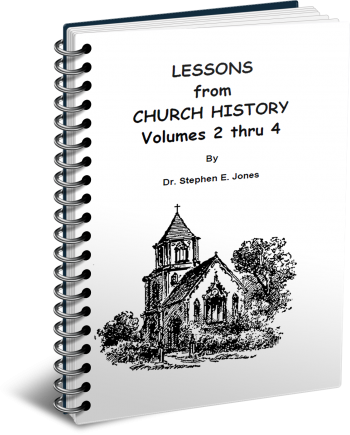Latest Posts
View the latest posts in an easy-to-read list format, with filtering options.

Volumes 2-4. This is the history of the Church from the Roman War (66-73 A.D.) to Constantine and the Council of Nicea in 325 A.D. with lessons to be learned from it.
Category - History and Prophecy

The capture of Valerian left his son, Gallienus, sole emperor of Rome. But it left him in a very precarious position, because the Romans believed that the fate of the empire hinged upon the fate of their emperors, who were, after all, worshipped as gods. In fact, this was, in large part, the underlying reason why the Christians were required to sacrifice to the Caesars. Caesars were the visible gods of the Roman Empire. The prosperity of the empire itself depended upon demonstrating piety toward its primary gods.
For this reason, for about six weeks Gallienus hid the fact that his father had been taken prisoner. And the rest of his eight-year reign was plagued by usurpers who tore large chunks out of the empire and created independent nations. The most significant of these revolts formed the Gallic Empire (260-273), which consisted of Spain, Gaul, Britain, and part of Germany. Though short-lived, it outlived Gallienus himself.
The creator of this Gallic Empire was Postumus, one of the generals sent to defend Gaul while Valerian and Gallienus marched east to fight the Persians. Postumus revolted in 260, perhaps after hearing that Valerian had been taken prisoner. Postumus was, in turn, murdered by his own troops in 268, at which time Spain and Britain declared their independence from the Gallic Empire. This created three independent nations out of what had been a single three-nation empire consisting of Spain, Britain, and Gaul.
Gallienus attempted to recover Gaul, but after being seriously wounded in battle in 263, he made no further attempt to do this. Most of his reign was spent in trying to hold rest of the Empire together. After his death in 268 there were four short-reigning emperors, showing a period of instability in the empire.
Then in 284 Diocletian became the emperor and put an end to what historians call “The Crisis of the Third Century.” Diocletian stabilized the Empire and was one of its greatest administrators. But he also brought one of the worst persecutions upon the Church in his later years.
During the reign of Diocletian, a Roman general named Carausius was sent to the English Channel with a fleet to counter pirates and raiders. But it appears that he kept the pirated wealth for himself and perhaps even waited for the pirates to raid villages before attacking them, in order to confiscate more wealth. Rome ordered him to be executed, but instead, Carausius declared himself to be Emperor of Britain, taking with him one of the legions from Gaul to add to the three legions already in Britain. He was later defeated in 293 by Constantius Chlorus, the father of Constantine. Carausius finally was killed by his treasurer, Allectus. Allectus, in turn, was defeated by Constantius in 296, and so ended the new Britannic Empire.
Constantius himself had married a Briton, Helen of York, Constantine's Christian mother.
An interesting detail about the reign of Carausius in Britain was that he understood the propaganda value of issuing coins. He issued coins made of good quality silver, contrasting with the debauched currency of Rome. His coins read “Restorer of Britain” and “Spirit of Britain.”
He also issued coins with the Latin letters RSR and INPCDA on them. These inscriptions puzzled historians until 1998 when they were recognized as an acronym of the sixth and seventh lines of the Fourth Eclogue of the Roman poet, Vergil. The English translation reads, “The Golden Ages are back, now a new generation is let down from Heaven above.” In those days Vergil’s poem was as famous in Britain as Shakespeare's plays are today.
Some of the coins also read, Expectate veni, “Come long-awaited one,” a line in Vergil's Aeneid. It appears, then, that Carausius was trying to appear as a messianic ruler, perhaps to appeal to the Christians in Britain, with whom Vergil was considered to be a Roman prophet.
By the year 298 Diocletian had stopped the Persians from invading Syria and had stopped the Germanic invasions in Gaul.
Diocletian instituted some very important reforms that kept the Empire intact for another century. Up to his time, the army was the real power base of the Emperor. Though he ruled technically as a constitutional monarch, it was in fact a dictatorship. Diocletian realized that the Empire was too big to be ruled by a single man, and so he divided the empire into East and West. He elevated Maximian to be Caesar of the West, while he himself ruled the East. Maximian moved his seat of authority north from Rome to Milan to be nearer to the frontier, and Rome never again became the seat of government for the Roman Empire. Later, when Constantine reunited the empire under himself as sole emperor, he built a new capital city and called it Constantinople.
In addition to Diocletian and Maximian, each chose a subordinate deputy Caesar, making a total of four caesars, each ruling about a fourth of the Empire. Diocletian chose Galerius to rule Anatolia, while in the West, Maximian chose Constantius to rule Gaul, Spain, and Britain.
Diocletian (Greece, Egypt, Asia)
Galerius (Anatolia and Oriens)
Maximian (Italy, North Africa)
Constantius (Gaul, Spain, and Britain)
Diocletian also recognized that religion added legitimacy to the Emperors, so he took upon himself the old title of Pontifex Maximus, making himself not only semi-divine, but also the “high priest.” He chose a new title for himself, Dominus et deus, (“Lord and God”). He also adopted for himself the title of Jovius (Jove, or Jupiter), and Maximian took the title of Herculius (Hercules).
In accordance with this new religious monarchy, of course, he frowned upon the Christians who refused to sacrifice to him or to recognize him as “Lord and God.” So he was determined to force their compliance or stamp them out completely. Whereas for the first 20 years he had respected the policy of toleration instituted by Gallienus in 260, in 303 he issued three edicts in rapid succession against the Christians.
The forty-year time of peace for the Church thus ended in one of the bloodiest persecutions ever instituted against them. Philip Schaff tells us in his History of the Christian Church, Vol. I, p. 66,
“In 303 Diocletian issued in rapid succession three edicts, each more severe than its predecessor. Maximian issued the fourth, the worst of all, April 30, 304. Christian churches were to be destroyed; all copies of the Bible were to be burned; all Christians were to be deprived of public office and civil rights; and at last all, without exception, were to sacrifice to the gods upon pain of death. Pretext for this severity was afforded by the occurrence of fire twice in the palace of Nicomedia in Bithynia, where Diocletian resided.”
The persecution began on February 23, 303 A.D., the Roman feast of Terminalia, as a symbolic gesture as if to terminate the Church. The persecution, however, was limited largely to the eastern part of the Empire. In the West (Gaul, Spain, and Britain), Constantius Chlorus and his son, Constantine, did everything possible to spare the Christians. Even so, because they were yet under authority, some churches were destroyed and a few Christians found martyrdom.
One would think that the Jews would be persecuted as well for not sacrificing to Caesar, but this was not the case. James Carroll writes in Constantine's Sword: The Church and the Jews, page 167,
“But going back to the first century B.C.E., Jews had been exempted from the requirements to offer sacrifices to and utter blessings in the name of pagan gods. When the Church grew apart from the synagogue, Christians lost that exemption, which posed a growing problem as the emperors themselves began, in the third century to claim the prerogatives of deity. Jews were also exempt from military service, but Christians were not.”
In 305, two years after instituting this persecution, Diocletian retired and persuaded Maximian to do the same in 308. Constantius Chlorus also died in 305. The power-sharing system began to fall apart at that point.
In 306 Constantine began his revolt in the West and took Rome in 312.